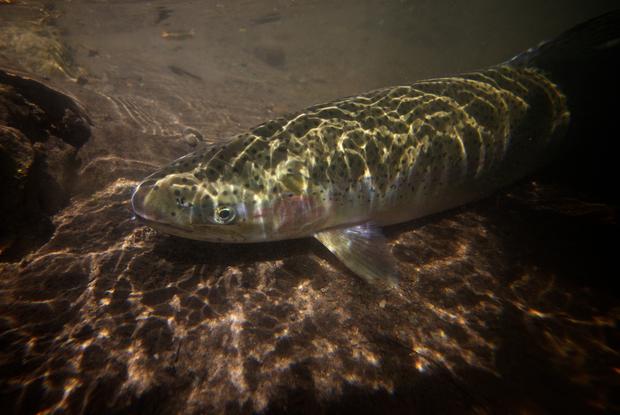forum
library
tutorial
contact

Fisheries Managers Forecast
'Unprecedentedly Low' Summer Steelhead
by George Plaven
East Oregonian, May 22, 2017
|
the film forum library tutorial contact |

|
Fisheries Managers Forecast
by George Plaven
|
The Oregon Department of Fish & Wildlife is forecasting
just 131,000 summer steelhead in the Columbia and Snake rivers.
 The Oregon Department of Fish & Wildlife is forecasting dramatically low returns of summer steelhead to the Columbia and Snake rivers, which will likely result in fishing restrictions for Northwest anglers.
The Oregon Department of Fish & Wildlife is forecasting dramatically low returns of summer steelhead to the Columbia and Snake rivers, which will likely result in fishing restrictions for Northwest anglers.
Tucker Jones, Columbia River program manager for ODFW, said the agency is predicting a total run of just 131,000 steelhead based on a number of factors, including the suffocating 2015 drought and warm water "blob" over the Pacific Ocean.
The agency met May 11 in The Dalles, and will meet again Wednesday in Clackamas to hear public input on recreational summer steelhead fisheries. However, Jones said some restrictions will be necessary to meet federal guidelines under the Endangered Species Act.
"Things don't look great for steelhead this year," Jones said. "The forecast is very low, and we have to operate under ESA constraints."
Fisheries managers are considering a plan that would close steelhead retention downstream of The Dalles Dam during the entire month of August; between The Dalles and John Day dams during the month of September; and from John Day Dam to the Oregon-Washington border during October and November.
"I think we are taking a logical and hopefully measured approach," Jones said. "The response so far has been fairly positive for the proposal."
This year's steelhead forecast is even lower than last year's disappointing run of 183,000 fish -- which itself was about 83,000 fewer than ODFW originally expected. So far, 2,050 steelhead have been counted on the Umatilla River at Three Mile Falls Dam, compared to 4,540 around the same time in 2016 and 6,050 in 2015.
The 2015 drought is one potential reason for the decline, Jones said, when ODFW temporarily banned fishing for trout, salmon, steelhead and sturgeon after 2 p.m. in most streams across the state. Adult and juvenile fish both had to contend with low flows and high water temperatures that proved fatal for cold water-loving salmonids.
Jones also pointed to "the blob," a mass of warm ocean water off the Northwest coast, that may have had an impact on migrating fish populations.
"There was not the normal assemblage of nutrient-rich prey," Jones explained, while adding it is hard to tell how exactly the ocean may have played a role in steelhead levels.
Bob Rees, executive director of the Association of Northwest Steelheaders, said the steelhead forecast is evidence that fish are suffering the effects of climate change and hydro dams across the Columbia and Snake river basins.
"We're just having to roll with the punches," Rees said. "These fish are pretty vulnerable to those environmental conditions that humans have had a hand in."
The Association of Northwest Steelheaders is a conservation and sport fishing advocacy group, and is one of the plaintiffs suing the federal government over its management of Columbia and Snake river dams to protect salmon and steelhead. That suit has been ongoing since 2001.
Rees said this year's steelhead forecast is nothing short of a crisis, though he said they are confident ODFW will implement proper measures for the season.
"There are some pretty important fisheries that are going to be sidelined because we have to protect these fish," he said.
Changes in fishing regulations will likely be announced within the next couple of weeks. Wednesday's ODFW meeting will be held from 6:30 to 8:30 p.m. at the ODFW Northwest Region Office, 17330 S.E. Evelyn Street, Clackamas. Comments can also be sent via email to either john.a.north@state.or.us or tucker.a.jones@state.or.us.
learn more on topics covered in the film
see the video
read the script
learn the songs
discussion forum
